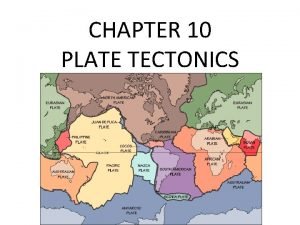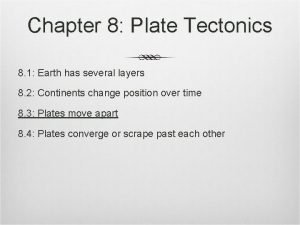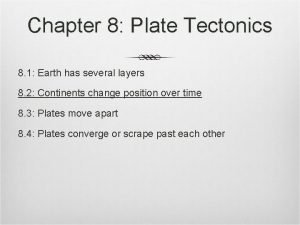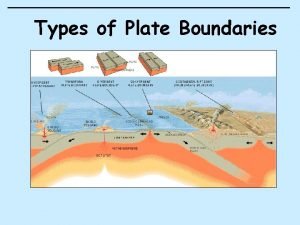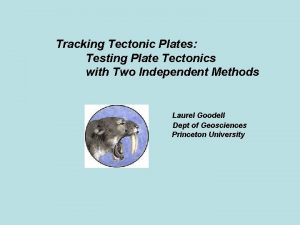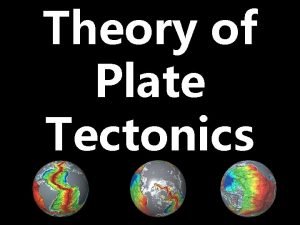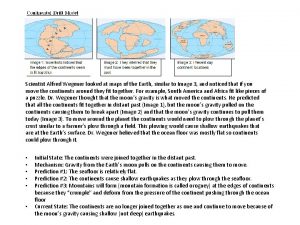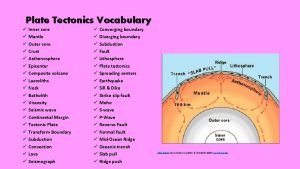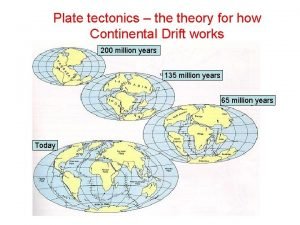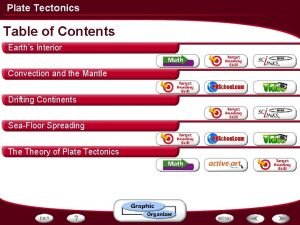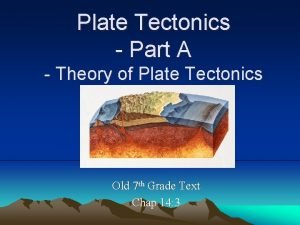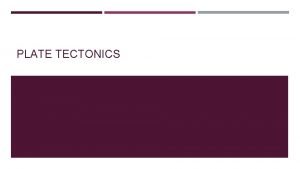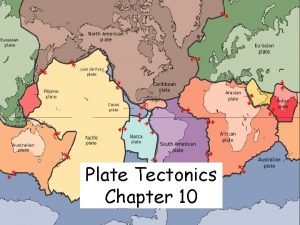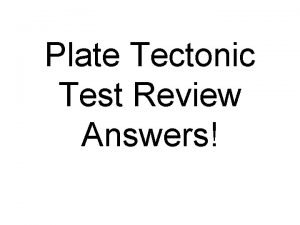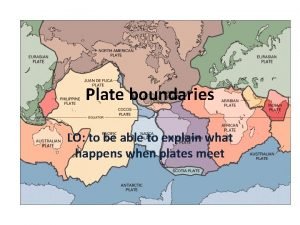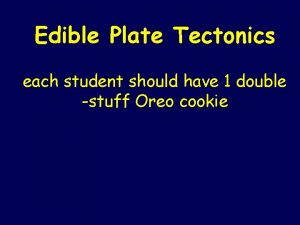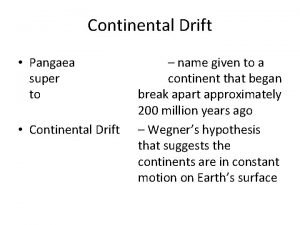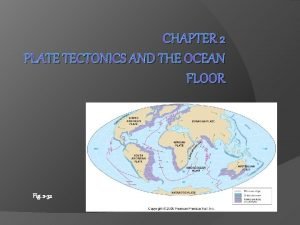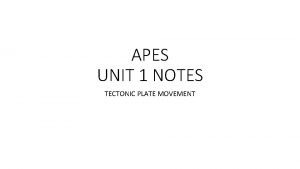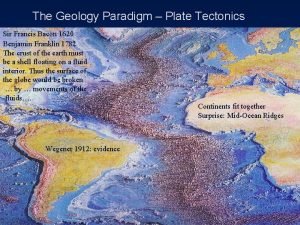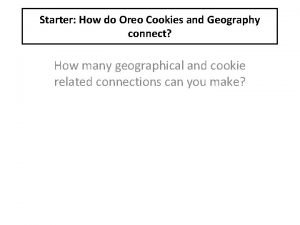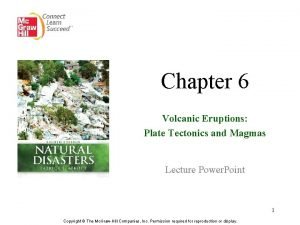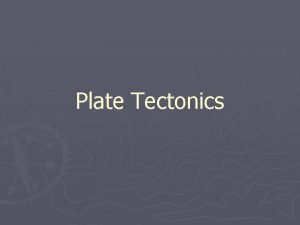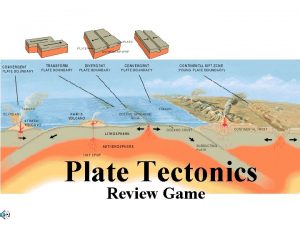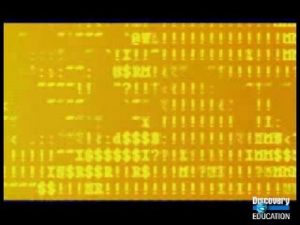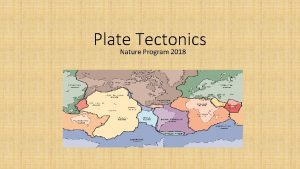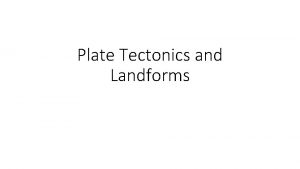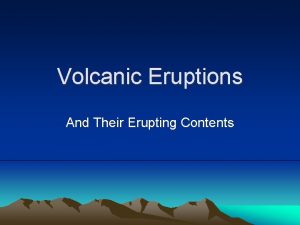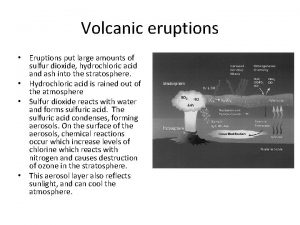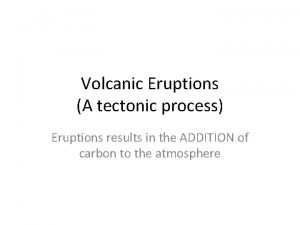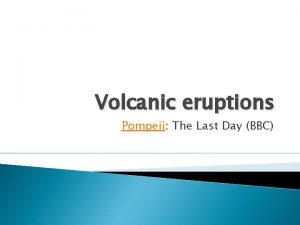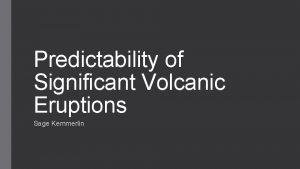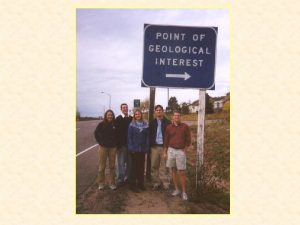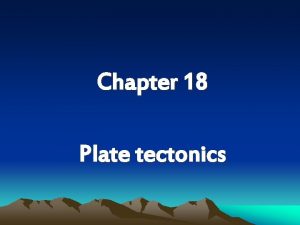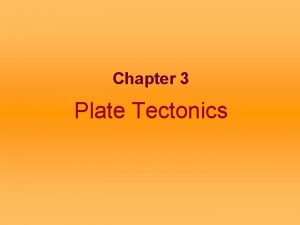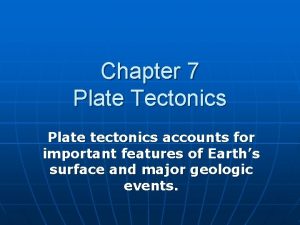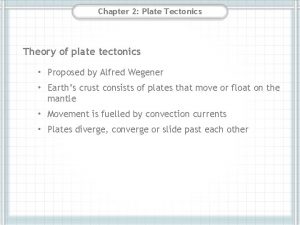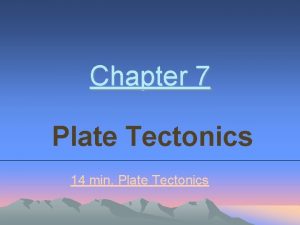Volcanoes Chapter 13 Volcanoes Plate Tectonics Volcanic eruptions


























- Slides: 26

Volcanoes Chapter 13

Volcanoes & Plate Tectonics • Volcanic eruptions can be caused by the movement of tectonic plates • Plates are moved by the internal heat of the Earth • A volcanic eruption can be more powerful than an atomic bomb

Formation of Magma • Magma – liquid rock that forms under Earth’s surface • Comes from melted crust and mantle

Volcanism • Magma naturally rises to the surface because it is less dense • The amount of magma increases because it melts rock along the way

Volcanism • Volcanism – any activity that includes the movement of magma onto Earth’s surface • Lava – magma that has reached the surface • Volcano – the vent in Earth’s surface where magma reaches the surface

Major Volcanic Zones • Like earthquakes, volcanoes tend to occur near convergent or divergent plate boundaries

Subduction Zones • Where one plate goes beneath another • Oceanic crust + oceanic crust = island arc chain • Oceanic crust + continental crust = mountain range

Mid-Ocean Ridges • The largest amount of magma comes to the surface at mid-ocean ridges • Forms under water volcanoes • Water quickly cools the lava creating pillow lava

Hot Spots • Volcanically active areas in the interior of a tectonic plate • The plate moves over the hot spot, causing a volcano to form • That volcano eventually moves away and a new one forms

Intrusive Activity • Magma that cools and solidifies under the ground (intrusion) • Forms plutons – Dikes (thin areas) – Batholiths (large areas >100 km 2) Devil’s Tower Wyoming

Exit Ticket 1. What is the difference between lava and magma? 2. Which of the following is the most accurate definition of volcano: • A. Any activity that includes the movement of magma toward or onto Earth’s surface. • B. Magma that flows onto Earth’s surface; the rock that forms when lava cools and solidifies • C. A mountain of rock that spews hot lava onto Earth’s surface • D. A vent or fissure in Earth’s surface through which magma and gases are expelled.

Do Now • Create a hypothesis that answers the question: • Which liquid will be able to trap the most bubbles when I blow into the liquid through a straw: water, cooking oil or honey? (Use I think… because… form) !

Viscosity • A fluids resistance to flow. • Magma can have different viscosities, which affect the force with which a particular volcano will erupt.

Volcanic Eruptions • 2 types of magma – Mafic – magma or rock rich in magnesium and iron; dark colored – Felsic - magma or rock rich in silicates; light colored

Types of Eruptions • Quiet Eruptions – Usually oceanic volcanoes (ex. Hawaii) – Lava has a low viscosity (runny) – Gases easily escape from the lava – Formed from mafic magma

Types of Eruptions • Lava Flows – Crust may form on top of the lava – If the lava keeps flowing, it forms wrinkles called pahoehoe Aa lava – surface breaks into jagged chunks Blocky lava – lava is more viscous (thicker)

Types of Eruptions • Explosive Eruptions – Usually continental volcanoes (ex. Mt. St. Helens) – Lava has a high viscosity (thick & sticky) formed from felsic magma – Gases trapped inside lava – Pyroclastic material – fragments of rock that form during a volcanic eruption • Thrown into the air during an explosive eruption

Pyroclastic Material • Volcanic ash – <2 mm in diameter • Lapilli – <64 mm in diameter – “little stones” • Volcanic bombs – Form when red hot lava is thrown and cools in the air • Volcanic blocks – Largest material – Pieces of rock blasted from the vent

Quick Check • Using the term viscosity, explain why a milkshake is harder to drink with a straw then a can of pop.

Calderas • Can form when the magma chamber empties and the cone collapses • Lakes can form in the caldera basin Crater Lake (Mount Mazama) Oregon

Predicting Volcanic Eruptions • Increase in strength and frequency of earthquakes may be a sign of an eruption • Before an eruption, the surface of a volcano may bulge outward from the magma • Scientists compare a volcano’s previous behavior to current measurements

Types of Volcanoes • The shape of a volcano is related to the composition of its matter. • http: //www. youtube. com/watch? feature=pla yer_embedded&v=u. Zp 1 d. Nybgfc

Types of Volcanoes • Shield volcano – Broad base; gently sloping sides – Covers wide area – Quiet eruption – Layers of mafic lava build up cone – Ex: Hawaiian Islands

Types of Volcanoes • Cinder cones – Very steep slopes – Rarely less than a few hundred meters high – Explosive eruptions – Cone made of pyroclastic material – Ex: Parícutin, Mexico

Types of Volcanoes • Composite volcano – Cone made of alternating layers of… • lava flows (quiet eruptions) • pyroclastic material (explosive eruptions) – Form large volcanic mountains – Ex: Mt. Hood, Mt. St. Helens, Mt. Rainier, Mt. Fuji

Exit Ticket The depression that results when a volcanic cone collapses over an emptying magma chamber is a: • A. Crater • B. Caldera • C. Vent • D. Fissure • Compare three main types of volcanic cones: Shield, Composite, and Cinder-Cone.
 Chapter 10 plate tectonics
Chapter 10 plate tectonics Chapter 8 plate tectonics
Chapter 8 plate tectonics Chapter 8 plate tectonics
Chapter 8 plate tectonics Plate tectonics vs continental drift
Plate tectonics vs continental drift Four types of boundaries
Four types of boundaries Plate motion calculator
Plate motion calculator The plate tectonics theory states that
The plate tectonics theory states that Continental drift theory and plate tectonics theory
Continental drift theory and plate tectonics theory Compare continental drift and plate tectonics
Compare continental drift and plate tectonics Plate tectonics webquest answers
Plate tectonics webquest answers Plate tectonics vocabulary
Plate tectonics vocabulary Continental drift vs plate tectonics theory
Continental drift vs plate tectonics theory Mantle convection and plate tectonics
Mantle convection and plate tectonics Plate tectonics definition
Plate tectonics definition Driving force of plate tectonics
Driving force of plate tectonics Plate boundaries
Plate boundaries Summarize the theory of plate tectonics
Summarize the theory of plate tectonics Harry hess and seafloor spreading
Harry hess and seafloor spreading Plate tectonic theory vs continental drift
Plate tectonic theory vs continental drift Plate tectonics test review answer key
Plate tectonics test review answer key Plate tectonic boundaries
Plate tectonic boundaries Plate tectonics with oreos
Plate tectonics with oreos Pangaea
Pangaea From now
From now Plate tectonics definition apes
Plate tectonics definition apes Francis bacon plate tectonics
Francis bacon plate tectonics Oreo cookies plate tectonics
Oreo cookies plate tectonics
